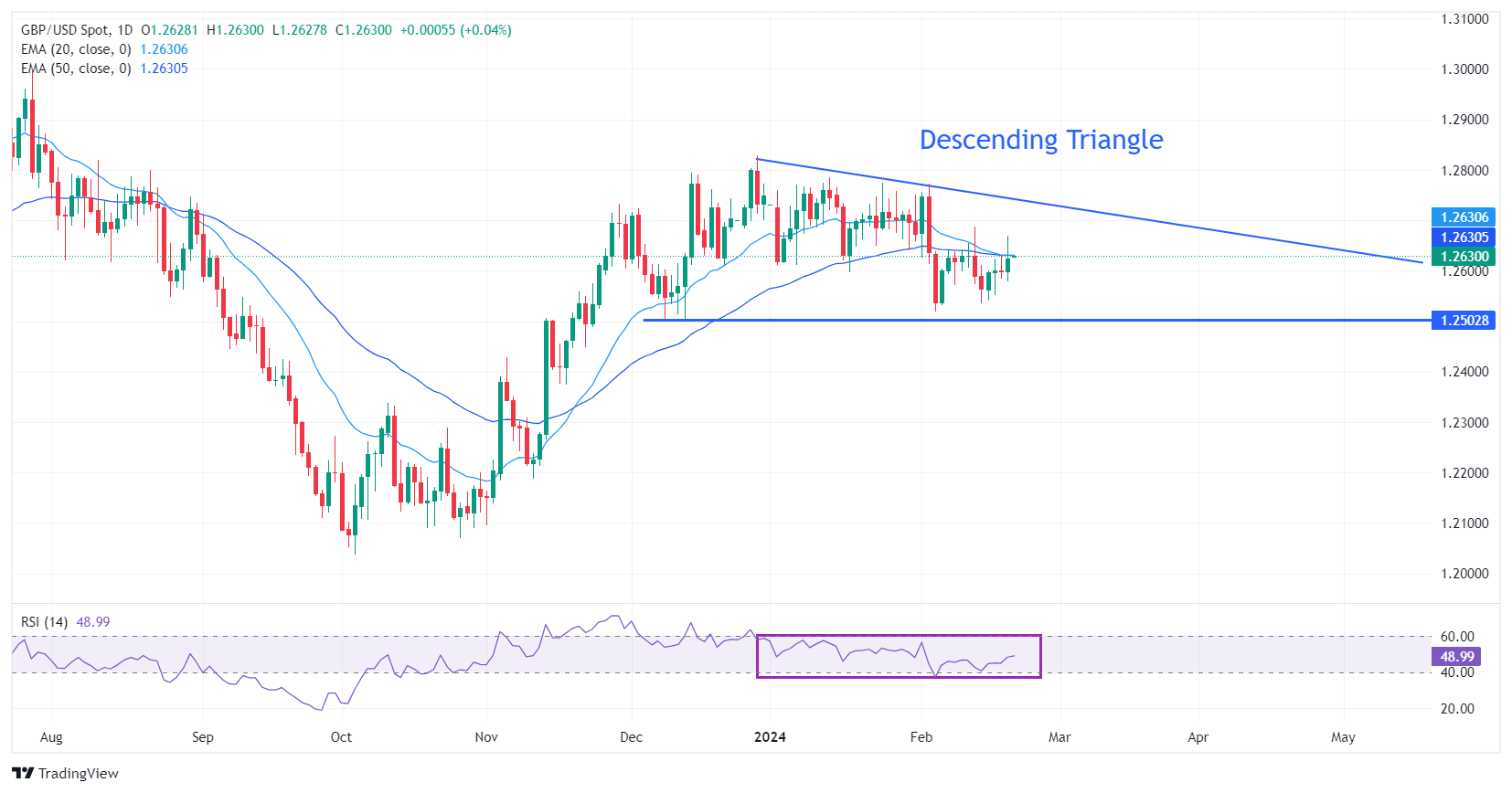- The British pound is pressured by the Bank of England's modestly dovish tone.
- BoE's Andrew Bailey backs market expectations for rate cuts.
- Investors are awaiting the FOMC Minutes.
The British Pound (GBP) struggles to maintain gains late in the European session on Wednesday, after setting a new weekly high near 1.2670. The bullish movement in the pair GBP/USD Tuesday was inconsistent with the pace at which the US dollar fell due to slightly dovish comments from Bank of England Governor Andrew Bailey and other policymakers speaking to UK lawmakers at Parliament's Treasury Select Committee. British.
Andrew Bailey said market expectations of rate cuts are not “unreasonable” and there are “encouraging signs” that price pressures are easing, but he declined to comment on the timing and degree of policy easing. restrictive.
Bank of England Deputy Governor Ben Broadbent said the central bank's focus had shifted from the degree of tightening of monetary policy to its duration. For her part, Swati Dhingra, head of monetary policy at the BoE, warned of the downward risks of restrictive interest rates for the British economy.
In today's session, the action in the Pound will be guided by the minutes of the Federal Open Market Committee (FOMC), which will be published at 19:00 GMT.
Daily Market Moves Summary: Sterling Struggles Amid Uncertainty Over BOE Rate Cut Timetable
- The British Pound corrects gradually to 1.2625, while the US Dollar bounces ahead of the release of the Federal Reserve (Fed) Minutes for the January monetary policy meeting.
- The FOMC Minutes will explain in depth the reasons for keeping interest rates in the 5.25%-5.50% range.
- The US Dollar Index (DXY), which measures the value of the dollar against six major currencies, continues to decline as Fed policymakers remain confident that inflation is moving in the right direction.
- Sterling fails to maintain gains as Bank of England Governor Andrew Bailey and his teammates claimed rate cuts may be announced before inflation falls to its 2% target, while speaking to the Treasury Select Committee of the UK Parliament on Tuesday.
- Andrew Bailey declined to comment on the timing of rate cuts, however, he supported market expectations for the reversal of the historically restrictive stance on interest rates.
- Andrew Bailey warned of the possibility of inflation picking up again after temporarily returning to target in the spring. He said the BoE wants to achieve price stability in a sustainable way.
- Asked about the economic outlook, Andrew Bailey said the technical recession in the second half of 2023 was historically modest, and a rebound was likely underway.
- For his part, the deputy governor of the BoE, Ben Broadbent, stated that the labor market is releasing ballast, which indicates that the current monetary policy is sufficiently restrictive.
- Ben Broadbent added that the central bank has shifted its attention to the duration of keeping interest rates at 5.25%, but rate cuts are not desirable at the current stage due to insufficient evidence.
- Broadbent's view is based on data indicating that wage growth and services inflation are at twice the pace consistent with sustainable consumer price inflation.
- Looking ahead, sterling will be guided by preliminary S&P Global/CIPS PMI data for February, which will be released on Thursday.
- The Manufacturing PMI is expected to come in below the 50.0 threshold at 47.5, up from the previous reading of 47.0.
Technical Analysis: Sterling remains above 1.2600

The British Pound faces pressure as it attempts to reclaim the two-week high of 1.2684. The GBP/USD pair is sideways, in the middle of a descending triangle formation on the daily chart. The mentioned chart patterns indicate a strong contraction in volatility, but with a slightly negative bias due to the formation of lower highs.
The descending edge of the descending triangle pattern is drawn from the December 28 high at 1.2827, while horizontal support lies from the December 13 low near 1.2500.
The 20-day and 50-day EMA near 1.2630 continue to act as a barrier for the British Pound bulls.
Meanwhile, the 14-period Relative Strength Index (RSI) is oscillating in the range of 40.00-60.00, indicating indecision among market participants.
Inflation FAQ
What is Inflation?
Inflation measures the rise in prices of a representative basket of goods and services. General inflation is usually expressed as a month-on-month and year-on-year percentage change. Core inflation excludes more volatile items, such as food and fuel, which can fluctuate due to geopolitical and seasonal factors. Core inflation is the figure economists focus on and is the target level of central banks, which are mandated to keep inflation at a manageable level, typically around 2%.
What is the Consumer Price Index (CPI)?
The Consumer Price Index (CPI) measures the variation in prices of a basket of goods and services over a period of time. It is usually expressed as a percentage of inter-monthly and inter-annual variation. Core CPI is the target of central banks as it excludes food and fuel volatility. When the underlying CPI exceeds 2%, interest rates usually rise, and vice versa when it falls below 2%. Since higher interest rates are positive for a currency, higher inflation usually translates into a stronger currency. The opposite occurs when inflation falls.
What is the impact of inflation on currency exchange?
Although it may seem counterintuitive, high inflation in a country drives up the value of its currency and vice versa in the case of lower inflation. This is because the central bank will typically raise interest rates to combat higher inflation, attracting more global capital inflows from investors looking for a lucrative place to park their money.
How does inflation influence the price of Gold?
Gold was once the go-to asset for investors during times of high inflation because it preserved its value, and while investors often continue to purchase gold for its safe haven properties during times of extreme market turmoil, this is not the case. most of the time. This is because when inflation is high, central banks raise interest rates to combat it.
Higher interest rates are negative for Gold because they increase the opportunity cost of holding Gold versus an interest-bearing asset or placing money in a cash deposit account. On the contrary, lower inflation tends to be positive for Gold, as it reduces interest rates, making the shiny metal a more viable investment alternative.
Source: Fx Street
I am Joshua Winder, a senior-level journalist and editor at World Stock Market. I specialize in covering news related to the stock market and economic trends. With more than 8 years of experience in this field, I have become an expert in financial reporting.







